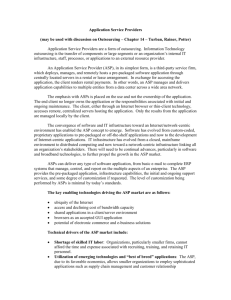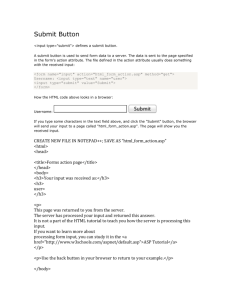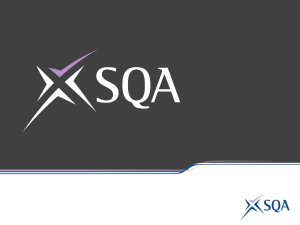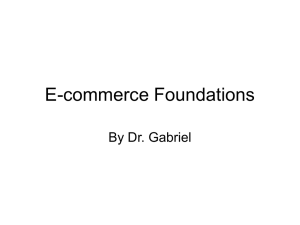web-centric ls-dyna - Free of Papers from LS
advertisement
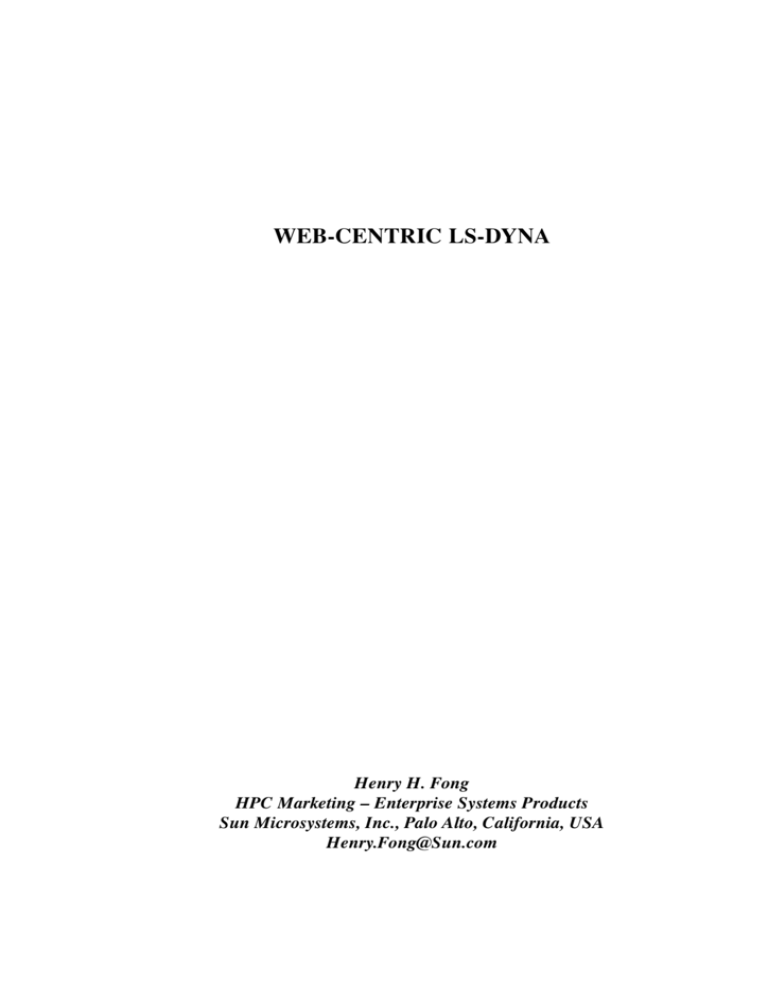
WEB-CENTRIC LS-DYNA Henry H. Fong HPC Marketing – Enterprise Systems Products Sun Microsystems, Inc., Palo Alto, California, USA Henry.Fong@Sun.com Introduction – HPC and ASPs The Internet has changed the way business is done – and High Performance Computing (HPC) is no exception. Many firms have launched “dot-com” software to facilitate B2B collaboration, outsource jobs, provide engineering services, or exchange data with suppliers and partners. Recently, however, hundreds of dot-coms have failed, and many high-tech companies have laid off thousands of workers. Now what? The term ASP (application service provider) has become popular in the past several years. ASPs deliver and manage applications and services remotely for multiple users – either through the Internet or a private network. An ASP owns the relationship with the end-user customer. Security tops the list of customers’ concerns. Hundreds of ASPs have sprung up, but most of these (e.g., Exodus, Qwest, Corio, EDS, Applicast, etc.) host computing services for commercial applications rather than technical ones. This paper introduces some basic concepts in portal supercomputing and ASPs, and suggests future directions LSTC and its worldwide distributors may wish to consider to web-enable LS-DYNA to make it accessible to a wider engineering community. Portal Supercomputing – The Sun Perspective Ever since its founding in 1982, Sun Microsystems has based its entire business philosophy on a singular vision – The Network is the Computer™. Sun recently extended the concept of open standards further, now promoting the service-driven network – which encompasses the four A’s, access of computing by anyone, anywhere, anytime, using virtually any device. Or, simply, A2A. A new emerging portal supercomputing model is service-centric, web-based, and shared-everything. Seven-day, aroundthe-clock (“24x7”) technical support is demanded by many customers. Access speed and security (although far from optimum) are improving daily, and global technical collaboration is becoming a reality. For HPC – especially in MCAE technologies – portal supercomputing promises to offer four key benefits: - a reduced total cost of ownership (TCO) due to reduced information resources and services at the enterprise level - easily accessible services and solutions for end-users and collaborators - a wider range of users and applications - competitiveness. Portal supercomputing is an evolution of time-sharing data centers (e.g., Control Data’s Cybernet Systems Services, Boeing Computer Services, etc.) from the 1970s. Many observers consider ASP to be time-sharing reborn with just another name. The difference: the Internet has enabled much broader and affordable access – in a less complex environment. Portal supercomputing typically has three essential elements: - thin clients – increasingly thinner clients (desktops, laptops, PDAs, etc.) use innovative software technologies such as Java™ and Jini™ to access portals. - web-based portals – these can be either internal or external portals - shared pools of resources – these include servers, networks, storage, operating systems, databases, and technical applications and libraries. The goal of web-centric HPC is to make access to these shared pools of resources transparent – with the most important benefit of these pools being efficient resource optimization. Indeed, some major manufacturers and MCAE ISVs are considering an ASP model. Sun Microsystems envisions that the automotive and manufacturing markets of the future will include a much larger service component and – like most other products – an information component. Furthermore, we believe that the economic model will shift from mass production to mass customization (see Sun Microsystems’ white paper on the global automotive industry, 2000; Ellis, 2000.) Sample CAD/PDM/MCAE/Collaborative Software and Services The September 4, 2000 issue of Design News magazine featured a supplement entitled “The Internet Revolution Comes to Software”. This pamphlet included a sample of seven Internet-related software packages/services: - PlaneCAD.COM – a Web portal - Engineering-e.COM – an engineering exchange website from MSC.Software that offers consulting services, software tools, outsourcing, and collaboration - Alibre Design Service – 3D solid modeler and data manage-ment tools for collaborative design - CoCreate/OneSpace – virtual conference room - PTC/Windchill – Parametric Technology Corporation’s CPC software - CollabWare/GS-Design – server-based design accessible for remote designers - Altair Engineering – ASP offerings including bundled packages such as the Altair/HyperWorks suite of MCAE software products. Other similar web-centric products/services and portals include, for example: - SDRC/Metaphase and Accelis – PDM and CPC software from Structural Dynamics Research Corporation - Unigraphics Solutions/Reasoned Revolution – Web-based product development - WebScope – a Web-native, Java 3D™-based software product for collaboration and communication (www.WebScopeInc.com) - CAEworld – a consortium offering CAE services worldwide (www.caeworld.com) - e-CFD – an on-demand CFD services on the Internet offered by Exa Corporation, SGI, and GTE Internetworking ($10 per cpu-hour, including the Exa/PowerFLOW license) - EnginFrame – a technical computing portal for internal/external ASPs, developed by an Italian firm Network Information Communication Engineering (www.nice-italy.com, www.enginframe.com). NICE Srl claims as its clients: in research – CNR, CASPUR; in automotive/aerospace – Fiat, Ferrari, Iveco, Alenia; in pharmaceuticals – Pharmacia, Upjohn; in energy – ABB Ricerche, Ansaldo; in telco – Telecom Italia, etc. The past few years have seen proliferation of a potpourri of business model names (B2A, B2B, B2C, B2D, B2F, P2P, etc. – see Glossary). And, industry analysts and OEM executives are trying hard to sort out all these changes and what they imply (Piszczalski, 2000; Vanzura, 2000). ASPs and COD Nope – ASP is not the poisonous African snake owned by Cleopatra, and COD is not the tasty fish. Many companies have come to the realization that hiring (as well as training and retaining) IT professionals to manage, monitor, and maintain increasingly complex computer systems takes valuable resources away from their core competency and business. Enters the ASP (see Sun Microsystems’ white paper on the elements of the ASP market, 2000; www.sun.com/ASP). The ASP’s value proposition to customers is compelling: - ASPs can cut the cost of using high-quality applications – but offer predictable fees - ASPs can reduce deployment cycles – customers need no new purchases - ASPs provide specialized expertise – customers need no hiring - ASPs eliminate the pain of software upgrades, administration, and upgrades - ASPs can offer capacity-on-demand (COD). The TCO and complexity of software applications can be dramatically different, depending on whether that application is ASP-based, web-enabled, or a conventional software rental (Gould, 2000). COD is a new pay-as-you-go trend for pricing server systems. For instance, the new Sun Fire MidFrame fat-node SMP server systems (8-24 750-MHz UltraSPARC III processors, with an ability to partition up to four dynamic domains) are sold only on a COD basis. Customers pay only for the computing capacity they currently need, but have the flexibility of easily adding processors/memory/storage and service when their computing demands increase in the future. Qwest offers enterprise applications and support for B2B software such as Ariba, Oracle, PeopleSoft, SAP, and Siebel. The largest web-hosting firm is Exodus Communications (www.exodus.com) in Silicon Valley, with over 400 ASP customers. ASPs who offer Sun computer systems include, for example: Synopsys, Computer Sciences Corporation, Cygnifi, Oracle Business OnLine, Portera, DoubleTwist, Asera, Corio, EDS, InfoCast, Interpath, NaviSite, PeopleSoft, USi, Conxion, NetASPx, and debis Systemhaus. Sun has initiated a collaborative industry effort and certification program to audit service providers and their infrastructure, hardware, software, and ultimately, overall service delivery – called SunTone‰ (www.sun.com/suntone-now). Sun also offers ASPs a “StartUp Essentials” and a “Sun Developer Connection” program. Of utmost concern to all ASP customers is security. A recent survey by Zona Research for the ASP Industry Consortium found that 96% of customers rate security as either “extremely important” or “very important” when considering a service provider. (See CNET Enterprise’s website on criteria for evaluating an ASP, www.enterprise.cnet.com.) A new German ASP, debis Systemhaus GmbH, with Daimler-Benz as its main customer, offers HPC compute cycles on Sun, HP, and NEC computers, and applications such as SAP, ABAQUS, LS-DYNA, MEDINA, PAM-CRASH, PEGASUS, and PERMAS (www.hpcportal.de). NetASPx is a large North American ASP specializing in HPC and technical applications (www.netaspx.com), and has garnered success in offering computing services to the manufacturing, petroleum, and financial industries. Conxion is an ASP that has teamed with MSC.Software to offer CAE computing services (www.conxion.net). MSC.Software and ANSYS, Inc. are both aggressively pursuing an ASP offering for their customers; MSC offers bundled software, rack-mounted hardware systems (with a small form factor), and expert consulting services. An ISV migrating to an ASP model has many issues to consider (see Sun’s guide on ISV- to-ASP migration, 2000). The benefits of adopting an ASP model include: - growing the ISV’s revenue - smoothen the revenue stream - increase customer satisfaction - get tighter control of customer relationships. Impact on MCAE Simulations Portal supercomputing, ASPs, and wireless access are expected to make an impact on MCAE computing over the next several years. How big an impact is anybody’s guess. The automotive and aerospace industries continue to undergo dramatic consolidations. Today, the six top automakers – General Motors, Ford, DaimlerChrysler, Toyota, Volkswagen, and Renault/Nissan – account for 63% of total global sales (Automotive News 2000 Data Book). Toyota, known for its manufacturing expertise and quality, has a market cap larger than Detroit’s Big Three combined. It has set a corporate goal of “zero prototyping” by 2004 – which means more and more simulations. These large OEMs demand innovative products and services, and require suppliers to use the same CAE tools and Covisint, ANX, or other web-based parts exchanges to collaborate, order, fulfill, and support orders. Different MCAE application codes demand different parts of the system architecture. For instance, crash simulation is CPU-intensive, with little demand on other resources. NVH has high demand for all resources – CPU, memory, storage, memory and I/O bandwidth. And, CFD is CPU-, memory-, and memory-bandwidth intensive. Attractive platforms for running compute-intensive MCAE applications such as LS-DYNA using the ASP model can be Sun’s Technical Compute Farm (a rack-mounted system featuring 16 UltraSPARC II cpu’s and a file server of 4 cpu’s) – bundled with Sun’s free Grid Engine load-balancing software, or the new UltraSPARC III-based Sun Fire 880 8-processor deskside workgroup server. At the Big Three, Cray supercomputers have been mostly replaced by large server systems in Detroit; there are currently an estimated 1,800 server cpu’s at the Big Three. Some OEMs and Tier 1 and 2 suppliers are seriously considering to outsource their computing needs and use an ASP model. The successful ASP vendor will likely be a partnership formed by: a leading hardware manufacturer; a hosting ASP vendor where all the computers are actually located; and possibly, a technical support services provider with expert knowledge on the CAE applications being used. ASPs use a variety of pricing models. Some charge a flat per-user or subscription fee based on the applications used. Others use a usage-based economic model, charging by the transaction, connect time, or other measurable feature. In addition to monthly fees, some ASPs also charge setup fees to help offset the expense of bringing new customers online. The myriad of complex business and technical issues faced by an ASP vendor includes, for example: - Access (Who pays for the access lines? Who owns these lines? What types of input devices are permitted access? How about wireless devices in the future?) - Security (Normally guaranteed by the machine-hosting partner – but how about security on the other end, at customers’ sites when the simulation results are transmitted back to the customer?) - Quality and guaranty (Who gets blamed when something goes wrong? Who guarantees what? How many “nines” does the ASP guarantee? How about a power blackout?) - Ownership and liability (Who actually owns the “product” or “solution”? Who’s liable?) - Technical support (Most ASP hosting companies do not possess sufficient MCAE expertise to solve or debug problems when technical difficulties arise. What is the best way to support the customers when something goes wrong? Should a “Technical Competency Center” be established that is staffed by top technical experts from all the partners – and does this center have to offer 24x7 support?) - Licensing and revenue split issues (Temporary licenses, global and corporate license, multi-year discounts, OEM vs. supplier licensing, choice of load-balancing software, etc. How to charge for normal versus peak usage? What is the proper metric for charging usage – a combination of cpu-hours, memory, storage, and I/O? Which set of MCAE software codes should be offered? How does one divide the software license revenue between the developer and a distributor who provides customer support?) - Intellectual property issues - Bandwidth (Many finite element models are huge, and transmitting them fast and securely during pre- and postprocessing phases – which can involve gigabytes of data – can pose quite a problem for slow lines and connections.) - Heterogeneous hardware platforms and operating systems (Who actually owns the computers, software, infrastructure, and access lines? How does one manage such a mix of heterogeneous hardware systems? What kind of discounts should a hardware vendor give to the hosting ASP web-hosting partner?) - Software upgrades – usually handled by the ASP’s IT staff, thus removing such hassles from the customer - Hardware and people resources (How to best handle unpredictable customer demands? How to optimize the deployment of computers, memory, disks, I/O – and people? How about training and support in other languages should customers dial in from European or Asian countries?) A Portal into the Future Ed Zander, President and COO of Sun Microsystems, recently offered a thoughtful glimpse into the future of the Internet (Zander, 2000), and some of his comments are relevant here. Excerpts from his article: “Driving a car designed before the improvements that came through extensive crash testing can be fatal. . . . Saying the Net changes everything now verges on understatement. . . . Technology is only half the battle. . . . When problems arise, they generally fall into two categories: operational and architectural. Operational problems result from not having a datacenter mentality. Architectural problems often result from not having one in the first place. . We tell customers: (1) design for the maximum volume you could possibly expect; (2) manage performance; (3) testing and monitoring are crucial. . . . The best sites have five environments: production, development, unit testing, integration testing, and failover. . . The whole Net economy depends on three things: reliability, scalability, and flexibility.” Sun Microsystems has developed WebDYNA, a prototype designed to web-enable LS-DYNA and a tool to provide remote access. Using Java applets and Servlets, this prototype repackages LS-DYNA from a command line application into a web application. With this tool, a user can submit jobs to LS-DYNA running on a server. After the server finishes processing the job, the user can see the results on a browser. This new way of accessing LS-DYNA facilitates the development of an ASP model in the future. (For more information on WebDYNA and suggestions on its contents, please contact Dr. Youn-Seo Roh at Sun Microsystems, youn-seo.roh@sun.com.) References Anonymous. The Global Automotive Industry 2000 – The Virtual Future. White paper, Sun Microsystems, Inc., Palo Alto, California, 2000. Anonymous. The Elements of the ASP Market. White paper, Sun Microsystems, Inc., Palo Alto, California, 2000. Anonymous. ISV to ASP Migration. Sun Microsystems, Inc., Palo Alto, California, June 2000. Ellis, John. “The future of the auto industry is building your own car over the Net.” Fast Company, December 2000, pp. 328-332. Fong, Henry H. “When the rubber hits the road – Megatrends in automotive manufacturing and simulation driven by computing advances.” Open Manufacturing, Fall 2000 issue, pp. 4-5, November 2000. Gould, Lawrence S. “Saving money on software by renting it”, Automotive Manufacturing & Production, November 2000, pp. 52-55. Piszczalski, Martin. “Myth and reality in automotive e-Business.” presented at e-Business Essentials: Job 1, Las Vegas, Nevada, November 6-8, 2000. Vanzura, Rick. “e-Auto revolution: transforming GM through electronic exchanges.” keynote address at e-Business Essentials: Job 1, Las Vegas, Nevada, Nov. 6-8, 2000. Zander, Ed. “The Net’s growing challenge: coping with unprecedented speed and volume in the dot-com world”, eBiz, Vol. 2, No. 5, Nov. 2000. (www.ebizmag.com) Glossary A2A anything-to-anything ANX™ Advanced Network Exchange – originally an automotive parts exchange virtual private network, now with almost 800 subscribers and expanded to include other transportation suppliers. Major subscribers include: GM, Ford, DaimlerChrysler, Honda, Nissan North America, Mitsubishi, Toyota, Caterpillar, Deere, Navistar, Paccar, Delphi, Visteon, Dana, Denso, Valeo, Goodyear, TRW, Magna, Lear, Eaton, Textron, etc. ASP application service provider B2A business-to-automotive B2B business-to-business B2C business-to-consumer B2D business-to-dealer B2F business-to-factory B2G business-to-government B2H business-to-home B2I business-to-individual CAD computer-aided design CAE computer-aided engineering (numerical simulation involving methods typically based on finite element analysis) CAM computer-aided manufacturing CFD computational fluid dynamics COD capacity on demand, an evolving pricing method for charging customers on a pay-as-you-go basis Covisint™ a new global B2B exchange developed by General Motors, Ford, DaimlerChrysler, Nissan, and Renault (www.covisint.com) CPC collaborative product commerce CPU central processing unit EDI electronic data interchange ERP enterprise resource planning FEA finite element analysis GUI graphical user interface HPC high performance computing, usually referring to technical computing iPLANET™ a leading software platform co-developed by Sun Microsytems and AOL/Netscape, which enables the rapid development, assembly, and deployment of scalable Internet services ISP Internet service provider IT information technology Java™ a Sun-developed language and cross-platform technology for building network-aware applications – with an estimated 2.5 million developers worldwide JES™ Java Embedded Services JVM™ Java Virtual Machine Jini™ a Sun-developed connection technology that enables devices and services to form spontaneous networks Jiro™ a Sun-developed open standards-based software for managing Net-based data storage MCAE mechanical computer-aided engineering – usually comprised of engineering analysis disciplines such as crashworthiness, occupant safety, CFD, NVH, structural analysis, heat transfer, kinematics, electromagnetics, etc. m-computing mobile computing (usually referring to small and ultra-light wireless devices such as web-browsing cellular phones and PDAs) MPI message passing interface (a de facto interprocessor communication protocol used among MCAE codes for multiprocessing) NIC numerically-intensive computing NVH noise, vibration, and harshness – analysis term usually used in the automotive industry OEM original equipment manufacturer P2P peer-to-peer computing – an emerging model whereby a single large task is split into many parts and distributed for processing to a large number of computers across a network. The earliest examples of P2P are music sharing (the Napster phenomenon), instant messaging, resource sharing, etc. PDA personal digital assistant (e.g., Palm Pilot, Handspring) PDM product data management SunTone™ a Sun-initiated certification program to audit service provider infrastructure, operational practices, hardware, software, and service delivery (www.sun.com/suntone-now) TCF Sun’s Technical Compute Farm product TCO total cost of ownership VSP vehicle systems provider VUI voice user interface XML extensible markup language, an emerging standard for web programming script



